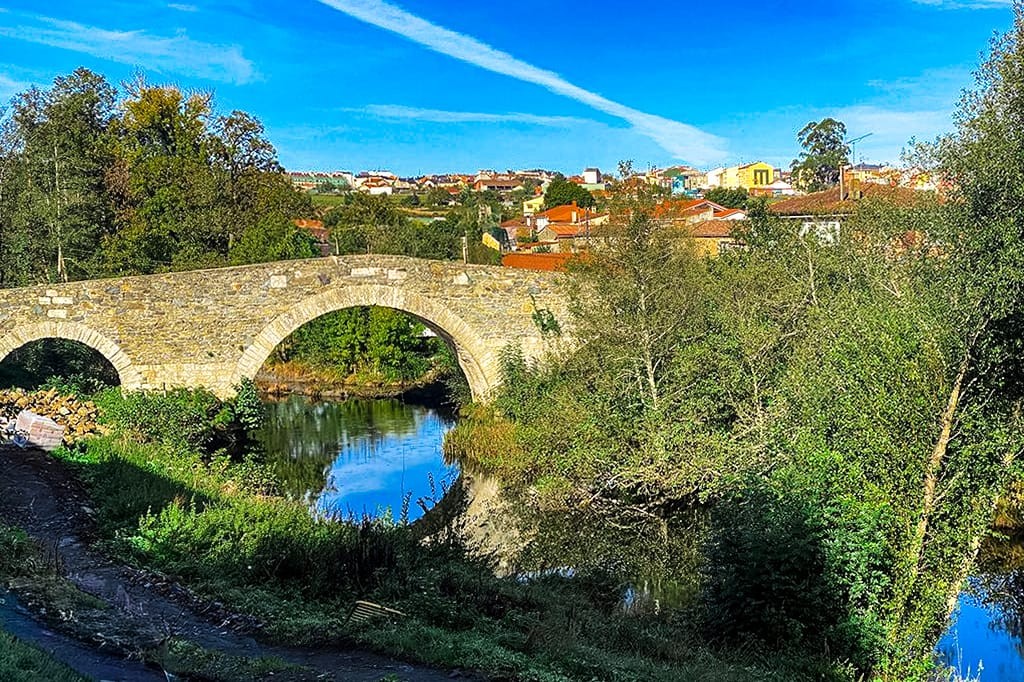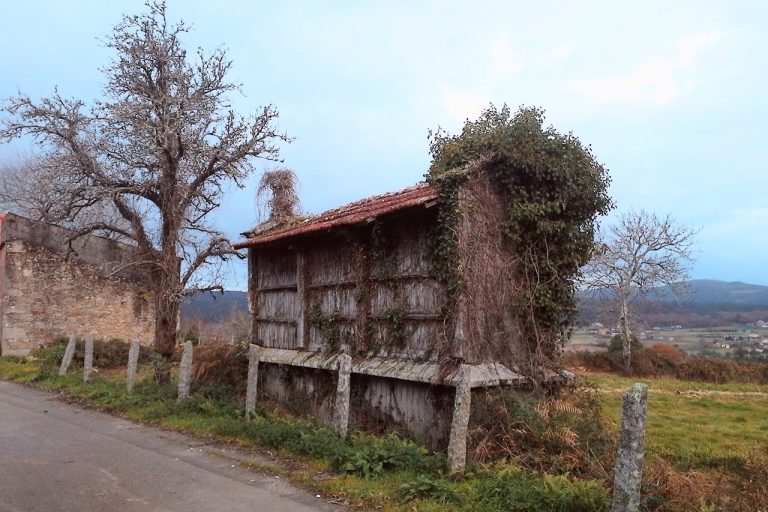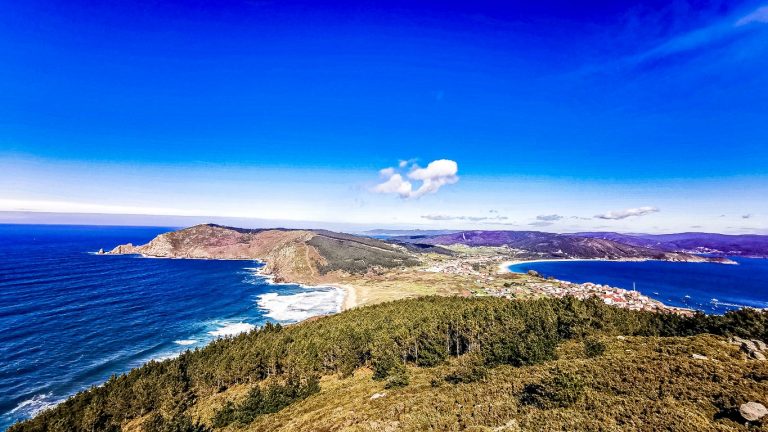
A New Stage Day – Beginning & Atmosphere
A fine haze lies over Palas de Rei as you take the first steps of this long day. It is a day of contrasts: rural and urban, historic and industrial, gentle and demanding. This stage demands more of your body than the elevation profile suggests – short, steep ramps, slippery hollow paths, the constant switch from asphalt to root trails. And yet: you walk through some of the most enchanting places in Galicia – over ancient bridges, through enchanted forests, past Romanesque churches, and through villages filled with the scent of cheese and chestnuts.
Route & Elevation Profile
- Distance: 29.2 km
- Elevation gain: approx. +520 m / –640 m
- Difficulty: Medium – physically demanding due to constant ups and downs
- Terrain: Mix of paved paths, forest tracks, cobblestones, hollow ways, and stretches close to traffic
This stage is a classic rompepiernas – a “leg-breaker.” Not because of its length, but because of its structure. The many short, intense climbs and descents break any rhythm. In the rainy season the path becomes muddy, slippery, and requires concentration – but also humility.












Variants & Small Detours
Some pilgrims split this stage:
- Variant 1: Palas de Rei → Melide (15 km)
- Variant 2: Melide → Arzúa (14.2 km)
For pilgrims with limitations or cyclists, it is advisable to use the LU-663 for certain sections, especially between Palas de Rei and Casanova – but beware: no shoulder, increased risk!
Description of the Way – With All Senses
You leave Palas de Rei via the N-547, soon immersing yourself in a little labyrinth of side paths and ancient cobblestones. The first climb takes you through the tiny hamlet of Riba, with its crooked barns and barking dogs, into a different world. A quiet woodland passage leads to San Xulián do Camiño, where the 12th-century Romanesque church awaits you. It stands like a guardian of past pilgrim times – modest, weathered, venerable.
After a short descent you reach Pontecampaña, a hamlet without many words, but with a pilgrim spirit lingering in its old stones. From here begins a section that will leave you in awe: moss-covered corridors, overgrown embankments, the scent of damp earth, and the call of the cuckoo accompany you to Casanova, a charming place with a welcoming wayside cross.
The path continues uphill – then steeply down to the Río Porto de Bois. You cross the little river on a stone bridge and climb the slopes from A Campanilla to O Coto, already in the province of A Coruña. Small bars invite you to rest – accept them, the hardest part is yet to come.
Through a chestnut-lined woodland path you arrive in Leboreiro, where a paved Roman road, a Romanesque church, and a former pilgrim hospital bear witness to centuries past. The path then leads past Disicabo, Madalena, through an industrial area – a contrast that almost hurts. But then the view opens onto Furelos with its fairytale 12th-century bridge. The village seems as though it has sprung from a painting of the Camino.
You climb to Melide, a crossroads of the Camino. Here the Camino Francés and the Camino Primitivo meet. Melide is bustling, lively, a place to rest – or to eat. The most famous specialty of Galicia awaits you here: Pulpo á Feira, octopus in paprika oil, freshly served on wooden plates.
Beyond Melide the play of hollow paths, streams, and bridges begins again. Via Santa María de Melide – a Romanesque jewel – you wander through forests, over wooden walkways, through Carballal and past an almost enchanted washhouse. In Boente an old wayside cross recalls the spring of Saleta, where you can refresh yourself.
Now begins another demanding section: climbs and descents alternate in quick succession. In Castañeda you touch the ground of history – here the limestones from Triacastela were once fired, stones that pilgrims carried on their backs to help build the cathedral of Santiago.
One last climb, a cool forest, a bridge over the Río Iso – and suddenly you find yourself in Ribadiso da Baixo, a place seemingly fallen out of time. The old stone pilgrim hospital, today an albergue, lies idyllically by the river – many say: one of the most magical places on the entire Camino.
With a heavy heart you continue – past gas stations, bars, and houses – and finally reach Arzúa, the gateway to the last phase of your pilgrimage.
Intermediate Villages & Special Features
| Village | Distance from Start | Feature | Tip |
| San Xulián do Camiño | 3.2 km | Romanesque church, former pilgrim hospital | Visit recommended |
| Pontecampaña | 4.4 km | Quiet hamlet | Refill water |
| Casanova | 5.6 km | Wayside cross & beautiful hollow ways | Enjoy nature |
| O Coto | 8.6 km | First village in A Coruña, café-bar | Breakfast stop |
| Leboreiro | 9.2 km | Roman road, Romanesque church, Casa de Ulloa | Historic photo spot |
| Furelos | 15.2 km | Medieval bridge, church, Caamaño coat of arms | Magical resting place |
| Melide | 16.6 km | Camino crossroads, Pulpo á Feira, churches & museums | Lunch break and stopover |
| Boente | 22.4 km | Saleta spring, wayside cross, church of Santiago | Water & spiritual pause |
| Castañeda | 24.6 km | Historic lime kilns | Read the info board |
| Ribadiso da Baixo | 27.8 km | Stone pilgrim hospital by the river, popular albergue | Ideal for rest or overnight stay |
| Arzúa | 29.2 km | Center of D.O. Arzúa-Ulloa cheese, Magdalena chapel | Taste the regional cheese |
Packing & Shopping Tips
- Water: Regular fountains & bars – but carry a reserve.
- Food: Melide & Boente well supplied, Ribadiso limited.
- Gear: Poles recommended (slippery hollow ways, short steep sections).
- Special tip: Don’t miss Pulpo á Feira in Melide – e.g. at “Pulpería Ezequiel.”
Food, Lodging & Services
- Palas de Rei: The starting point of this stage is well equipped. From the large municipal albergue to modern hostels like Zendoira, Os Chacotes, or Castro, to family-run houses like A Casina di Marcello. Those seeking more comfort will also find it: hotels such as Casa Benilde or Hotel Mica offer quiet nights and often pilgrim menus in their restaurants. An ideal start for the long day to Arzúa.
- On the way: Between Palas de Rei and Melide lie small villages like Casanova or O Coto, with simple yet welcoming hostels and bars. Boente also has accommodation and cafés, lively in the afternoons – a meeting point for pilgrims of all nations.
- Melide: A true crossroads on the Camino. Here not only does the Camino Primitivo join, but you’ll also find a wealth of accommodation: from the large municipal albergue to family-run houses like Alfonso II, O Cruceiro, or San Antón. For those seeking more peace, hotels like the traditional Carlos 96 or Hotel Xaneiro provide comfort. And, of course, don’t miss the legendary pulperías – Ezequiel or A Garnacha are almost mandatory.
- Ribadiso da Baixo: Few pilgrims forget this place. The albergue de peregrinos, housed in a former stone pilgrim hospital directly on the river, is one of the most striking accommodations of the Camino. Staying here, you fall asleep to the sound of the water – an experience many call magical. Alternatives include the private Los Caminantes, cozy Milpés, or the small Hostal Ribadiso.
- Arzúa: At the end of the day, Arzúa offers a wide range of albergues and guesthouses. From the large modern Vía Láctea with over 100 places, to the smaller Amodiño with its warm atmosphere, to the centrally located Ultreia. For more peace or comfort, pensions and hotels such as Domus Gallery, O Retiro, or the classic Hotel Suiza are ideal. Arzúa caters to every need – whether you prefer community or a private room for your last night before Santiago.
Today’s Highlights
- Leboreiro is a quiet place, yet its soul resonates: pilgrims of the Middle Ages walked the same Roman road you now tread. Their steps still seem to echo in the joints, their breath lingers in the moss.
- Furelos, with its medieval bridge, carries you into another moment – more than a crossing, it is a passage between time and being. Some moments on the Camino bring everything together: scent, taste, atmosphere, history.
- A fuller moment awaits in Melide, and it smells of paprika, olive oil, and fresh octopus – pulpo, cooked in a large copper pot.
The famous Pulpo á Feira here is not just a meal – it is ritual, encounter, and reward in one. In places like Pulpería Ezequiel or A Garnacha, you find rustic wooden tables, waitresses in aprons, steaming plates, and the rhythmic chopping of scissors cutting the octopus. With bread, Ribeiro wine or an Albariño, and a simple “¡Buen provecho!” from fellow pilgrims who, for a moment, become companions.
This moment in Melide is more than lunch – it is memory in the form of taste. Whoever stops here carries not just energy for the way ahead, but a piece of true Galicia in the heart. - And Ribadiso – whoever has rested there never forgets the silence. Light falls gently through the trees, the water whispers softly of moving forward.
- Finally Castañeda, reminding you: every pilgrim contributes to what makes Santiago’s cathedral – you too, with every step, every effort.
At the end of a varied stage day, Arzúa welcomes you, where the Camino Francés joins the Camino del Norte – a symbolic meeting point. Here converge pilgrim streams who have walked hundreds of kilometers along very different ways, now sharing the final steps to Santiago.
Arzúa is also home to Arzúa-Ulloa cheese, one of Galicia’s culinary emblems. Mild, creamy, and full-bodied, it is more than a regional specialty – it is part of the region’s identity. In Arzúa, the stage ends not only geographically, but it also unites: people, cultures, paths, and stories, merging into a single flow over the last kilometers.
Reflection at Day’s End
Today you walked through history, over bridges of centuries, through forests of faith and villages full of pilgrim legends. Each climb, each slippery path carried you further – physically tired, inwardly fulfilled. Arzúa is not Santiago. Yet today you are meaningfully closer.
📊 Tabular Overview
| Stage | Start | End | Distance | Elevation +/– | Difficulty | Key Villages |
| 31 | Palas de Rei | Arzúa | 29.2 km | +520 / –640 | Medium | Melide, Boente, Ribadiso, Castañeda |
🌌 Camino of the Stars – Stage 31
Palas de Rei → San Xulián → Pontecampaña → Casanova → O Coto → Leboreiro → Furelos → Melide → Boente → Castañeda → Ribadiso → Arzúa
Which place touched you most today – Leboreiro, Furelos, or Ribadiso? Or was it the pulpo in Melide? Share your moment on the Way!


